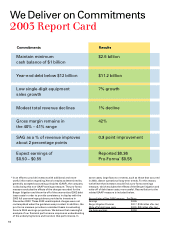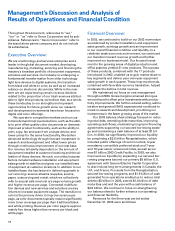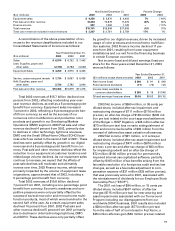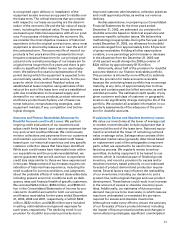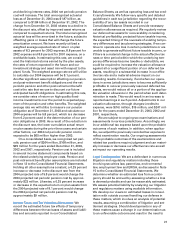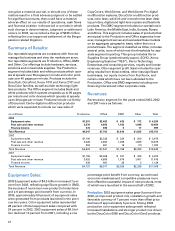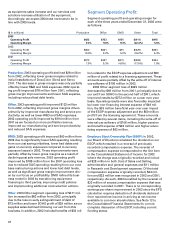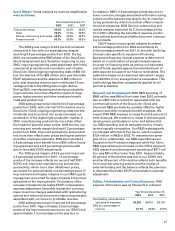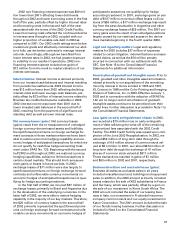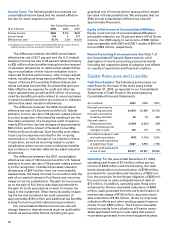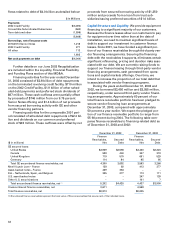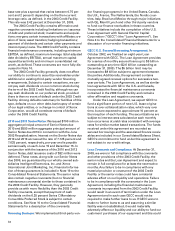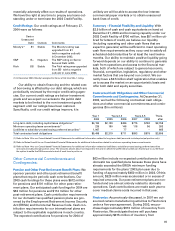Xerox 2003 Annual Report Download - page 27
Download and view the complete annual report
Please find page 27 of the 2003 Xerox annual report below. You can navigate through the pages in the report by either clicking on the pages listed below, or by using the keyword search tool below to find specific information within the annual report.
25
The DocuColor iGen3 utilizes next generation color
technology which we expect will expand the digital
color print on demand market. 2003 production
monochrome equipment sales grew modestly as light-
production installations, driven by the success of the
new Xerox 2101 copier/printer, and favorable currency
more than offset declines in production publishing,
printing and older technology light lens. 2002 equip-
ment sales declined 8 percent from 2001 reflecting
price declines of approximately 5 percent, weaker
product mix and installation declines driven largely
by older technology light lens equipment.
Office: 2003 equipment sales grew 5 percent from
2002, as favorable currency of 7 percent and installa-
tion increases more than offset price declines of
approximately 10 percent and the impact of weaker
product mix. Equipment installation growth of approx-
imately 20 percent reflects growth in all monochrome
digital and color businesses, particularly office color
printing and our line of monochrome multifunction/
copier systems. The CopyCentre, WorkCentre and
WorkCentre Pro systems, which were launched in the
second quarter 2003, are intended to expand our mar-
ket reach and include new entry-level configurations
at more competitive prices. 2002 equipment sales
declined 5 percent from 2001, with approximately two-
thirds of the decline driven by older technology light
lens products. The remainder of the decline was due
to price declines of approximately 10 percent and
weaker product mix, which more than offset installa-
tion growth in our digital products.
DMO: 2003 equipment sales grew 27 percent from
2002, reflecting volume growth of over 40 percent,
partially offset by price declines of approximately 10
percent and unfavorable mix.
Other: 2003 equipment sales declined 14 percent from
2002 due to general sales declines, none of which
were individually significant. 2002 equipment sales
declined 53 percent from 2001, primarily reflecting our
exit from the SOHO business in 2001.
Post Sale and Other Revenue:
2003 post sale and other revenues of $10.5 billion
declined 4 percent from 2002, including a 5-percent-
age point benefit from currency. These declines reflect
lower equipment populations, as post sale revenue is
largely a function of the equipment placed at customer
locations and the volume of prints and copies that our
customers make on that equipment as well as associ-
ated services. 2003 supplies, paper and other sales of
$2.7 billion (included within post sale and other rev-
enue) declined 2 percent from 2002 primarily due to
declines in supplies. Supplies sales declined due to
reduced usage in the lower installed base of equip-
ment and our exit from the SOHO business in 2001.
2003 service, outsourcing and rental revenue of
$7.7 billion declined 4 percent from 2002, reflecting
declines in rental and facilities management revenues.
Declines in rental revenues primarily reflect reduced
equipment populations within DMO and declines in
facilities management revenues reflect consolidations
by our customers as well as our prioritization of prof-
itable contracts. 2002 post sale and other revenues of
$10.9 billion declined 5 percent from 2001. 2002 sup-
plies, paper and other sales of $2.8 billion declined
8 percent from 2001, primarily reflecting declines in
supplies. 2002 service, outsourcing and rental revenue
of $8.1 billion declined 4 percent from 2001 driven
primarily by lower rental revenues in DMO.
Production: 2003 post sale and other revenue declined
2 percent from 2002, as favorable currency and
improved mix, driven largely by an increased volume
of color pages, were more than offset by the impact of
monochrome page volume declines, primarily in older
technology light lens products. 2002 post sale and
other revenue declined 2 percent from 2001, as
declines in monochrome page volumes more than
offset the impact of improved mix due to significant
growth in color page volumes.
Office: 2003 post sale and other revenue grew 1 percent
from 2002, as favorable currency and strong digital
page growth more than offset declines in older tech-
nology light lens products. 2002 post sale and other
revenue declined 6 percent from 2001, as declines in
older technology light lens products more than offset
strong digital page growth.
DMO: 2003 post sale and other revenue declined
16 percent from 2002, due largely to a lower rental
equipment population at customer locations and relat-
ed page volume declines. 2002 post sale and other rev-
enue declined 16 percent from 2001, due to a reduction
in the amount of equipment installations at certain
DMO customer locations as a result of reduced place-
ments in prior periods.
Other: 2003 post sale and other revenue declined
10 percent from 2002, reflecting supply sale declines
in SOHO of $82 million as well as the absence of
$50 million of third-party licensing revenue recognized
in 2002. See Note 3 to the Consolidated Financial
Statements for further discussion.
We expect 2004 equipment sales will continue to
grow, as we anticipate that new products launched in
2002, 2003 and those planned in 2004 will enable us to
further strengthen our market position. Our ability to
increase post sale revenue is dependent on our suc-
cess at increasing the amount of our equipment at
customer locations and the volume of pages generat-
ed on that equipment. In 2004, we expect post sale
and other revenue declines will continue to moderate



